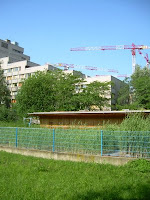
what is the relative importance of greenroof plants? published work suggests that plants may be negligible for water storage on greenroofs and serve primarily to prevent erosion and maybe shade the media surface.
The roof shown here was probably 90% covered with plants, but there were still some gaps. Should roof owners be concerned about gaps? How important is planting density? The fll guidleines recommend a minimum of 60% plant coverage for extensive roofs.








































